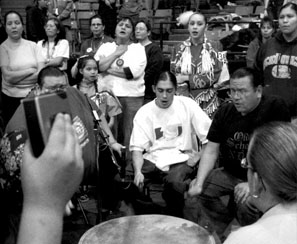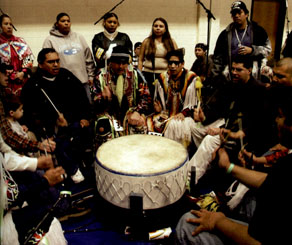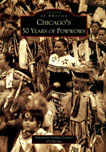|

 |
Chicago's Fifty Years of Powwows |
<Adapted from the book of the same name>
The Third Circle: Songbirds
In powwow country, women singers are known as canaries or songbirds. Women's voices fuse with the men's voices to form beautiful harmonies, instilling strength and pride in our children and honoring those who came before us.
Songs are composed for many purposes. Women continue to perform for specific occasions including: songs for delivering babies, for childless women to have children, lullabies, food gathering and preparation, songs that are connected to making utilitarian necessities (i.e. clothing, pots, tools, etc), as medicine for female illnesses, mourning or burial songs, and animal songs related to medicine or story songs.
In Chicago, a continual practice of elder to youth or cultural bearer to youth learning is common. The importance of the third circle is recognized as women hold a position of respect. One story explains that woman is closer to the Creator as she also is a life giver. Therefore, it is the responsibility of the second circle to protect the heartbeat while the third circle nurtures the heartbeat.
Still today women warriors seek to create healthy communities and mend the circles in our lives and the lives of others around us. These warriors are mothers, daughters, sisters, grandmothers, and wives. They are also honored and respected healers, educators, students, artists, activists, scientists, and dancers.
Forward to the next page of this essay Back to the previous page of this essay Back to the menu page for this essay Back to Online Essays
|
| |
Department
of Anthropology |
copyright ©
2002 University of Illinois, All rights reserved. |




